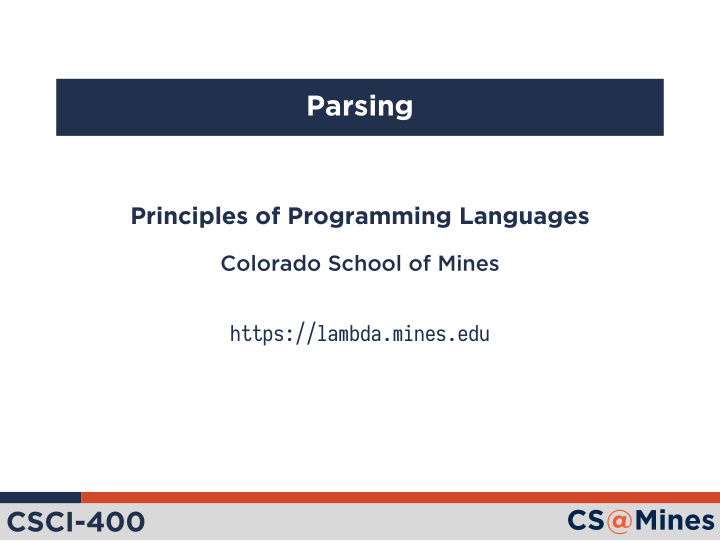



Parsing Principles of Programming Languages Colorado School of Mines https://lambda.mines.edu CSCI-400
Activity & Overview CSCI-400
Review the learning group activity with your group. Compare your solutions to the practice problems. Did anyone have any issues with the problems? Then, as a learning group, work on a regular expression to match double-quoted string literals: What you should match is shown in bold . Try your regular expressions at the Python REPL. Learning Group Activity print( "Hello, World!" ) if (strcspn(cmdline, "'\"`" ) != strlen(cmdline)) { printf( "<text:p text:style-name=\"Glossary\">" ); escape( "\"1 < 2\"" ) CSCI-400
this: presumably, might be for some programming language): How does our language implementation know what to do with this code? How do we determine the order of operations on this Suppose we have the following source code (which, How can we represent this code in memory in a way that makes it easy to evaluate or compile? How do we handle cases where programmers write the same expression but with difgerent spacing or style, like Parsing: High Level Overview alpha = beta + gamma * 4 expression so that we compute beta + (gamma * 4) rather than (beta + gamma) * 4 ? alpha=beta+gamma *4 CSCI-400
parentheses: Product is a and nesting of Product id: beta Value Sum id: alpha Assign child of Sum here. The goal of parsing is to Conveys order of operation id: gamma Value int: 4 tree . The abstract syntax using an abstract syntax We typically represent this interpret compile. that makes it easy to code into a representation convert textual source Value Parsing: Goal is Code to AST tree for alpha = beta + gamma * 4 is shown. CSCI-400
Parsers are typically implemented using two stages: Lexical Analysis During lexical analysis, the input is tokenized to produce a sequence of tokens from the input. Syntactic Analysis During syntactic analysis, the tokens from lexical analysis are formed into an abstract syntax tree. Parsing: Two Stages CSCI-400
Lexical Analysis CSCI-400
During lexical analysis, we tokenize the input into a list tokens consisting of two fjelds: Token Type Data (optional) Tokens which won’t appear in the AST are called control tokens : these control the operation of the parser. Lexical Analysis alpha=beta+gamma*4 LA → Id(alpha), Equals, Id(beta), Plus, − Id(gamma), Times, Int(4) CSCI-400
Lexical Analysis: Implementation tokens_p = re.compile(r''' \s*(?: (=)|(\+)|(\*) # operators | (-?\d+) # integers | (\w+) # identifiers | (.) # error )\s*''', re.VERBOSE) def tokenize(code): for m in tokens_p.finditer(code): if m.group(1): yield Equals() ... elif m.group(5): yield Id(m.group(5)) elif m.group(6): raise SyntaxError CSCI-400
Syntactic Analysis CSCI-400
During syntactic analysis, we turn the token stream from the lexical analysis into an abstract syntax tree. In general, there’s two ways to parse a stream of tokens: Top-Down: form the node at the root of the syntax tree, then recursively form the children. Bottom-Up: start by forming the leaf nodes, then forming their parents. Syntactic Analysis Id(alpha), Equals, Id(beta), Plus, Id(gamma), Times, Int(4) SA − − → AST CSCI-400
In order to parse a language, we need a notation to formalize the constructs of our language. We defjne a set of production rules that state what the various constructs are formed of: This is actually a specifjc kind of context-free grammar called a LR (left-recursive) grammar. It makes it convenient for using shift-reduce parsers (coming up!) Language Grammars Assign → Id Equals Sum Sum → Sum Plus Product Sum → Product Product → Product Times Value Product → Value Value → Int Value → Id CSCI-400
Shift-reduce is a type of bottom-up parser. We place a cursor at the beginning of the token stream, and parse each step using one of two transitions: Shift: move the cursor to the next token to the right. Reduce: match a production rule to the tokens directly to the left of the cursor, reducing them to the LHS of the production rule. We refer to the token just to the right of the cursor as the lookahead token . We use the lookahead token to determine that the left of the cursor can unambiguously be reduced, otherwise we will shift. Example on Whiteboard Example shown on whiteboard of using our grammar to create an AST using shift-reduce. Shift-Reduce Parsing CSCI-400
Recommend
More recommend